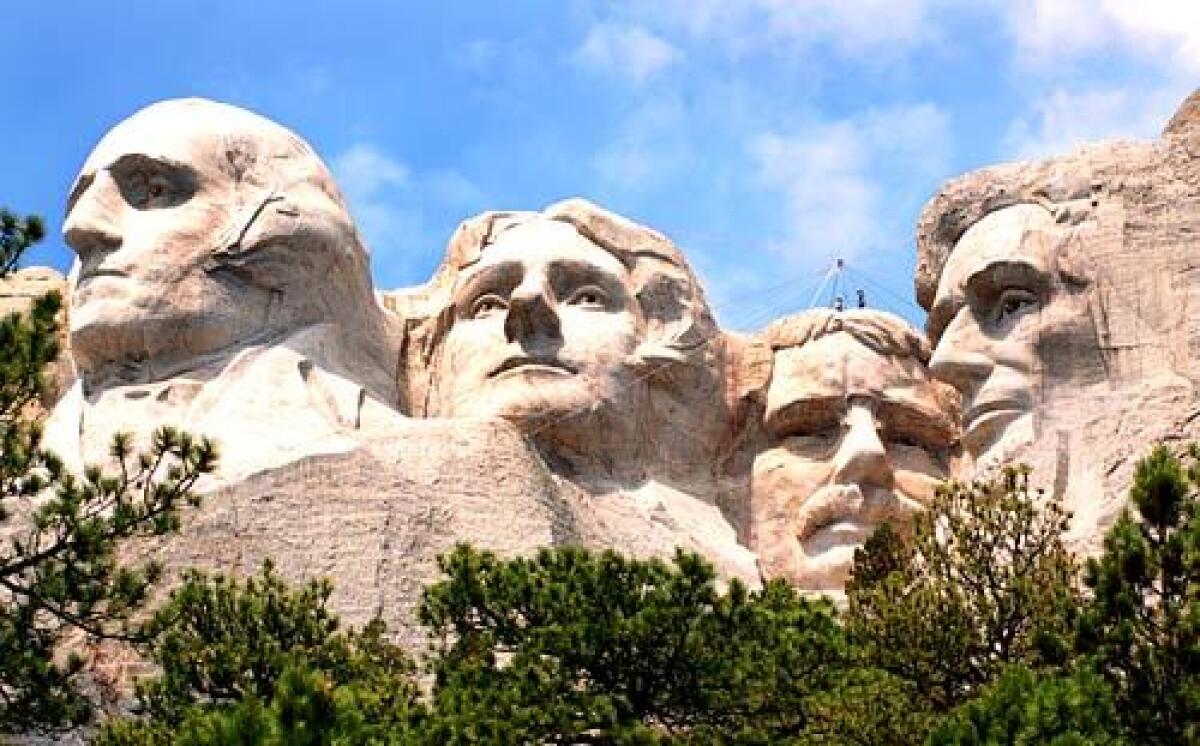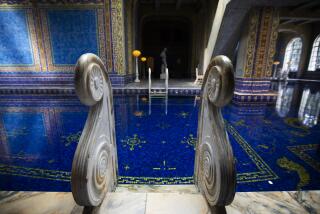For July 4, national parks plan restrictions, closures and one Trump party

- Share via
U.S. national parks, which typically swell with legions of visitors on Independence Day weekend, will this year mark the holiday with restricted access, two late-breaking, coronavirus-related closures in Texas and a presidential visit at Mt. Rushmore.
One closure is at Big Bend National Park and the Rio Grande Wild & Scenic River, which shut its gates Thursday morning, “until further notice,” an NPS statement said.
Ranger Adam Prato said the cause was an NPS staffer who tested positive for the novel coronavirus that causes COVID-19. “That person is in isolation, and we’re closing the park” while others go into quarantine and health officials work on contact tracing, Prato said.
About 500 miles east of Big Bend, Padre Island National Seashore announced Wednesday that it would close all beaches and beach camping, from 8 p.m. Thursday to 6 a.m. Tuesday.
Meanwhile, at Mt. Rushmore National Memorial, about 7,500 visitors (who got tickets through a lottery) are expected for a Friday night fireworks celebration where President Trump is expected to appear.
South Dakota Gov. Kristi Noem, a Republican, has told Fox News that masks will be provided but optional at the event and that “we won’t be social distancing... We told those folks that had concerns that they could stay home.” The Mt. Rushmore site will be closed to the public Friday and will reopen early Saturday.
Get inspired to get away.
Explore California, the West and beyond with the weekly Escapes newsletter.
You may occasionally receive promotional content from the Los Angeles Times.
California’s national parks, still gradually reopening after shutting down in March, are expected to remain open through the Independence Day weekend. This comes amid Gov. Gavin Newsom’s continued urging that Californians postpone leisure travel until the pandemic eases.
Rangers, hoping to slow the spread of COVID-19, have many restrictions and closures in place.
In Yosemite National Park, for instance, only day-trip visitors with advance reservations are allowed in, and the park is capped at 1,700 day-tripping vehicles per day. Though the park’s lodgings are open at limited capacity, the only campground open in Yosemite Valley is Upper Pines, at half-capacity.
That means just 120 campsites in Yosemite will be occupied for the weekend. Rangers said in a phone recording Thursday morning that all camping reservations for the weekend had been claimed through the park’s booking site, recreation.gov.
At other California parks:
Channel Islands National Park. This park never officially closed, but once concessionaire Island Packers stopped running daily boats, visitor traffic dried up. On June 1, Island Packers resumed running boats to the islands but at reduced capacity to give passengers more room. The Santa Barbara Adventure Co. has resumed kayak tours on Santa Cruz Island.
Get The Wild newsletter.
The essential weekly guide to enjoying the outdoors in Southern California. Insider tips on the best of our beaches, trails, parks, deserts, forests and mountains.
You may occasionally receive promotional content from the Los Angeles Times.
Death Valley National Park. The park has partially reopened — it was the last of the California national parks to do so — just in time for summer temperatures sometimes surpassing 110 degrees. In late June, park officials announced the reopening of most park roads, trailheads, restrooms and overlooks, including Badwater Road, Dante’s View, Artist Drive, Golden Canyon and Ubehebe Crater. Also open: Furnace Creek, Emigrant, Mesquite Flat, Saline, Eureka, Homestake, Wildrose, Thorndike and Mahogany campgrounds, along with many back-country roads. Rangers are again collecting entrance and camping fees. The Oasis at Death Valley, a privately owned complex of hotel rooms, restaurants and shops that serves as the park’s principal commercial hub, opened June 18. The Furnace Creek Visitor Center and Stovepipe Wells Ranger Station remain closed. Because of the heat, rangers urge visitors not to hike at lower elevations after 10 a.m.
Golden Gate National Recreation Area. The area’s popular Muir Woods site opened in late June, with mandated advance parking reservations. Still closed: Alcatraz, the Golden Gate Bridge Welcome Center, Point Bonita Lighthouse and all campgrounds and picnic sites, along with visitor centers at the Presidio and Lands End. Now open: Conzelman Road (famed for its view of the Golden Gate Bridge), parking at Stinson, Muir and Rodeo beaches, parking at Tennessee Valley, Fort Baker and Horseshoe Cove.
Joshua Tree National Park. Most campgrounds are open, but its visitor centers remain closed. Like Death Valley, the park gets perilously hot in the summer.
Sequoia & Kings Canyon National Parks. The roads, trails, restrooms and picnic areas of Kings Canyon and Sequoia are open. On July 6, rangers will open Potwisha Campground and Lodgepole Campground in Sequoia and Sunset Campground in Kings Canyon, with reservations required through recreation.gov. Other campgrounds in the parks remain closed for now, and all previous 2020 camping reservations in the two parks have been canceled as part of pandemic closures and restrictions.
Lassen Volcanic National Park. Hiking trails have reopened (except Bumpass Hell, which remains closed because of snow hazards), as have the park’s 30-mile highway and Butte Lake and Warner Valley roads. Permitted back-country camping has resumed too. Walk-in campgrounds at Manzanita Lake and Southwest have opened. Seasonal campgrounds will open on previously scheduled dates; check Lassen’s website. The visitor center and museum remain closed.
Redwood National and State Parks. Trailheads and parking lots have reopened, as well as restrooms, though guests are advised to bring soap and hand sanitizer. Visitor centers and campgrounds remain closed.
Pinnacles National Park. The western entrance near Soledad is open from 8 a.m. to 8 p.m. The eastern entrance near Paicines is open but with limited parking. Visitors should arrive before 11 a.m. or after 3:30 p.m to get a spot. The campground on the eastern side remains open; visitor centers are still closed.
Santa Monica Mountains National Recreation Area. The area, which straddles Los Angeles and Ventura counties, has reopened most of its trails, parking lots, overlooks and restrooms. Its two visitor centers remain closed, as are some areas damaged by the Woolsey fire in 2018.
More to Read
Sign up for The Wild
We’ll help you find the best places to hike, bike and run, as well as the perfect silent spots for meditation and yoga.
You may occasionally receive promotional content from the Los Angeles Times.






